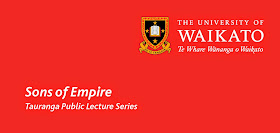From the utmost end of the Earth: New Zealand and World War One.
Sons of Empire is an eight-part public lecture series commemorating the 100th anniversary of World War One. Each weekly presentation focuses on delivering a unique New Zealand perspective of WWI: the voices of our soldiers, from the battles and the trenches to their legacy of literature; the diaries, the images and the poetry that remain.
This series is brought to you by the University of Waikato in collaboration with the Tauranga Historical Society.
Sons of Empire will be launched at the Tauranga Bongard Centre with a brief introduction by the Deputy Vice-Chancellor of the University of Waikato Alister Jones along with the President of the Tauranga Historical Society, Stephanie Smith. The audience will have an opportunity for questions which will be followed by light refreshments.
All series will be held at the Tauranga Bongard Centre, Lecture Theatre 104. Each lecture will occur on a Wednesday evening from 6.30pm onwards.
17 Sept - Dr Kirstine Moffat – “Poetry, Protest, and WW1”
24 Sept - Fiona Kean – “Public Opinion in Tauranga from ‘Letters to the Editor’”
1 Oct - Stephanie Smith – “The diary of a BOP Camelier”
8 Oct - Sue Baker Wilson – “NZ Engineers Tunnelling Company”
15 Oct - Dr Damien Fenton – “The Mundane Realities of Trench Warfare”
22 Oct - Dr Nathalie Philippe – “The Liberation of Le Quesnoy”
29 Oct - Dr Cliff Simons – “The Gallipoli Campaign”
5 Nov - Dr Mark Houlahan – “Kiwis and the Shakespeare Hut, London”
Registration: Bookings are essential for this free series so please register by emailing nyree@waikato.ac.nz. For any enquiries please phone 027 286 7454.



















